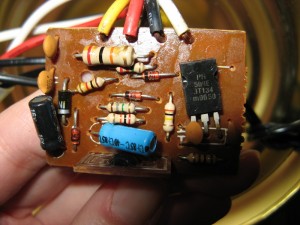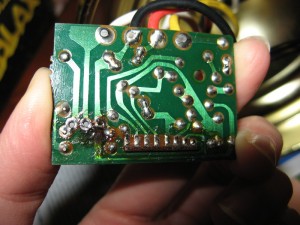February 7th, 2011 at 9:23 pm (Education, Mathematics, Reflection)
From the What I Learned Yesterday files…
I have always loved numbers, especially in terms of manipulating them. Remember those arithmetic drill books, endless columns of 3 + 6 and 12 – 5 and every other possible combination? I loved paging my way through them, filling up all of the blank spots. My grandmother’s living room had a big bay window with a flat base I could crawl onto (I don’t think it was intended as a seat), behind the curtains, and I loved to hole up there with that book. Even *better* was when I encountered those drills in elementary school, and they were *timed*! Hooray, a race!
But even before those memories glows a beautiful eureka moment I hope I’ll never forget. I was in daycare, somewhere between 4 and 5 years old, musing about multiplication (for no reason I can recall), when suddenly I Got It. I jumped up and ran around trying to share the shining vision that I’d had. The best I could do then was, “But it’s so simple! Two times two is just 2, two times!”
I still remember those words, and I remember the lack of a similarly excited response from the other kids. Was it incomprehension? Disinterest? I couldn’t seem to put my revelation into words that made sense to anyone else, and I was buzzing with commingled frustration and joy. At that moment, the “x” sign had ceased being an arbitrary symbol specifying a relation to be memorized. Instead, it had *meaning*. I was swimming in triumph at the feeling of having *cracked the code*, seeing yet another pattern but also the whys behind the pattern. (Of course, when I reached elementary school, I then got to memorize the multiplication tables, like everyone else. So much for eureka…)
I have a handful of other memories from that daycare. Conspiring with a friend to stash our pears from lunch, which we hated, in our pockets for later disposal. Sprawling on threadbare green carpet in front of the TV and goggling at afternoon cartoons. Singing “This Old Man, he played one, he played knick-knack on his thumb…” Discovering awe and predation on finding a black widow spider out back. Discovering how surprisingly hard other kids can pinch if you don’t wear green on St. Patrick’s Day. Shivering at horror stories about loose baby teeth being tied to a door and extracted with a slam, then rushing to the bathroom to inspect my own teeth for any worrisome looseness. But these have all faded in a way that my “2, two times” moment has not. And it left me with an appetite for that feeling of “Oh wow, I get it!” that is what makes the study of anything new so very delicious. More learndorphins, anyone?
2 Comments
0 of 2 people learned something from this entry.
February 4th, 2011 at 9:40 pm (Electronics)
Some time ago, I wrote about the demise of my touch-lamp. After the bulb burnt out, the lamp no longer responded to touch. A bit of research online suggested that the triac had likely been destroyed by the bulb’s dying throes. It looked like this could be solved by replacing that part, but I wasn’t quite up to tackling it on my own.
Times have changed! I read through some excellent repair instructions (thanks to a helpful commenter on my original post) which noted that most such lamps are equipped with a BT134 or BT136 triac, which can only handle up to 4 amps of current. Simply replacing this component with a BT139 triac should solve the problem forever — BT139s can handle up to 16 amps. Thus encouraged, I pulled the base off my lamp and found, to my delight, that the author of those instructions was spot-on: my lamp had a BT134! Here’s the whole circuit board, with the three-pronged triac on the right:

The letters on the triac say “PH 500E BT134 m9650”. I’ve located the equivalent BT139 part which costs all of $1.19. (What’s sad is that the BT134 costs $0.87, so for just 32 cents more, the manufacturer could have saved me this hassle. But most manufacturers probably don’t want to spend 32 cents more to build the lamp even if I am willing to pay 32 cents (or even a dollar!) for a higher-reliability product, since they’re doing mass production and mass advertising and trying to beat their competitors’ prices, etc.)
The next step is to remove the old part and replace it with the new one. My boyfriend Evan seized on this opportunity to teach me how to solder. He demonstrated soldering two wires together, and I eagerly observed and then got to try it myself. Unlike stained-glass soldering (my only previous such experience), you don’t use flux to prep the surfaces you’re joining, but instead the solder has a “rosin” core that performs the same function. The solder container had a warning on it that included “do not breathe the solder fumes, and wash hands before eating or smoking”, which cracked me up. You heat the soldering iron above 370 F (the melting point of solder), wipe the tip of the iron on a sponge to clean it, then “tin” the tip with a dab of solder. You use the iron to heat the wires to be soldered, so that they are hot enough to melt the solder as well (rather than touching the iron to the solder directly, which would be harder to direct where you want it). On touching the tip of the (solid) solder to the hot wires, it melts and flows into crevices and gaps to seal the wires together.
After joining the two wires, Evan showed me how to desolder, both with a copper wick (an absorbent braided fabric that sucks up liquid solder) and with an aspirator (that suctions the liquid solder away). Encouraged by this example, I desoldered the bad triac out of the circuit board. Here’s the result (this is the back side of the board shown above; the desoldering took place on the left side near the scorch mark):

Now I just need to wait for the new triac to arrive, then borrow a soldering iron and stick it back in. (Or maybe I’ll have my own soldering iron by then!) And then, victory over the broken lamp will be mine!
Update (Feb. 13, 2011): I have successfully fixed the lamp!
10 Comments
5 of 8 people learned something from this entry.

